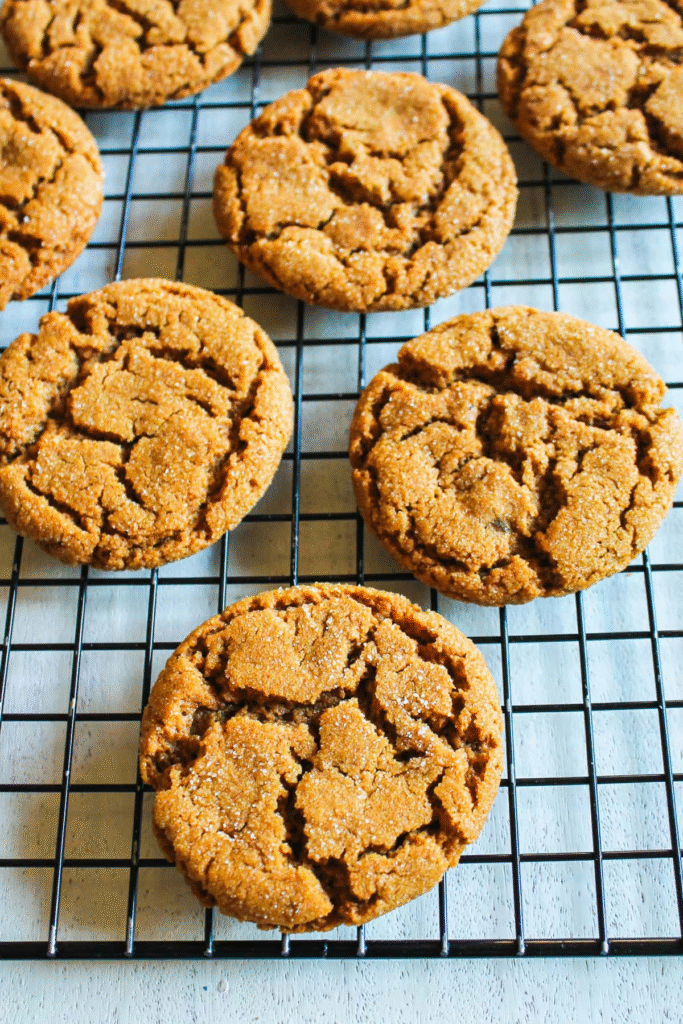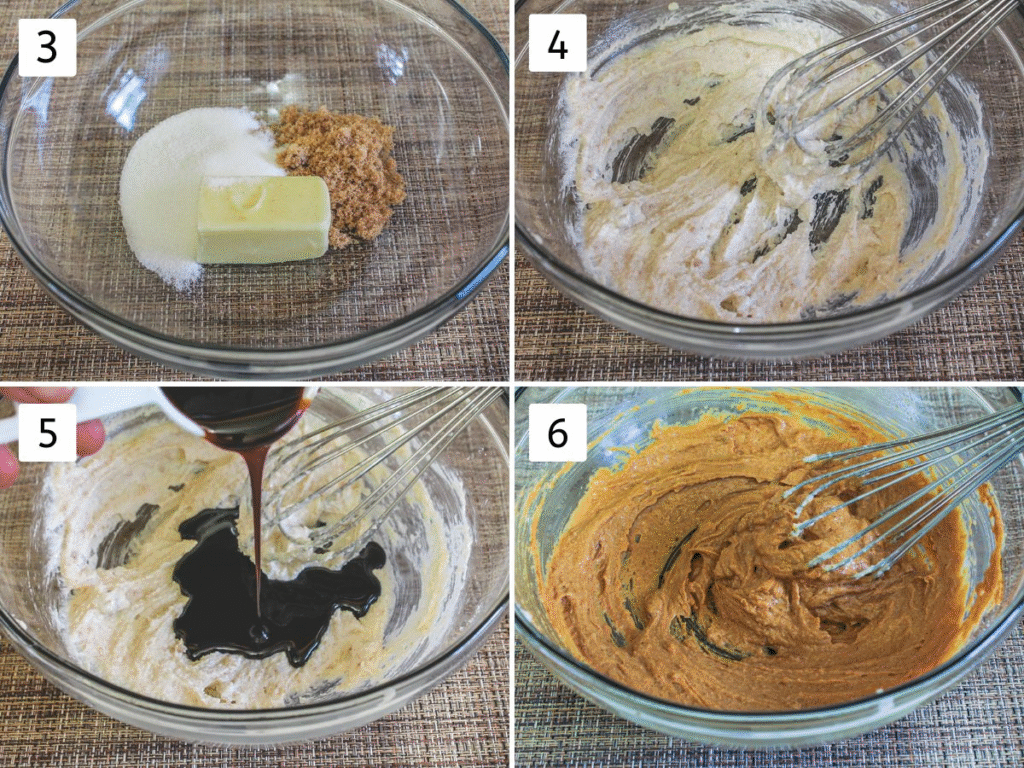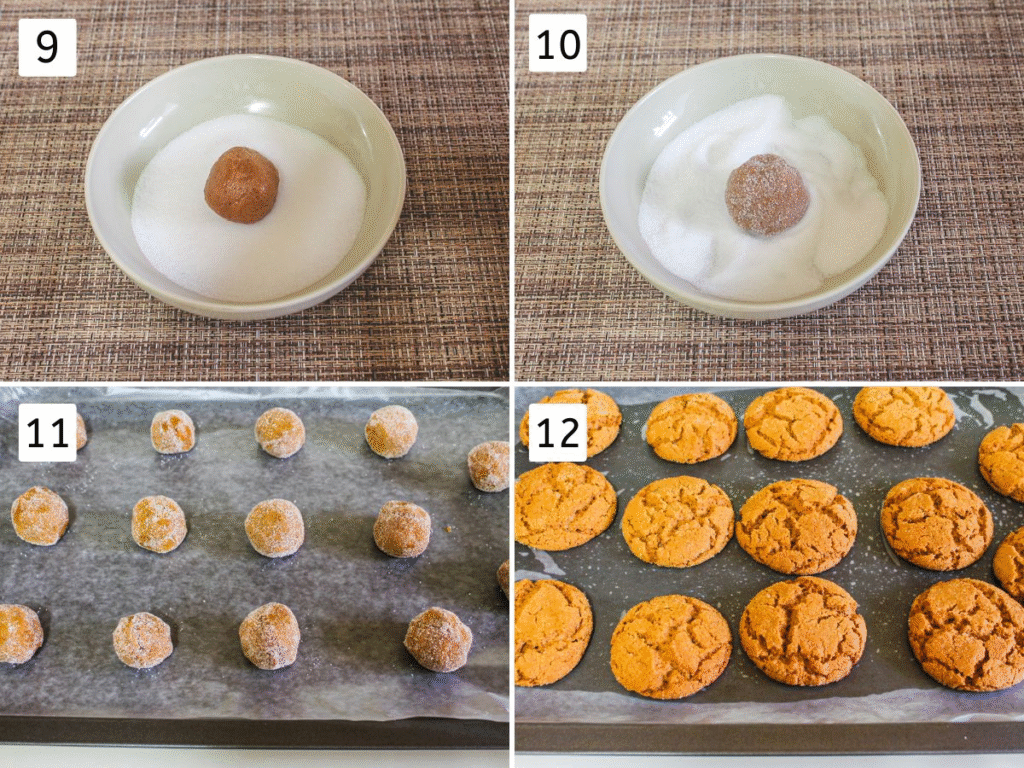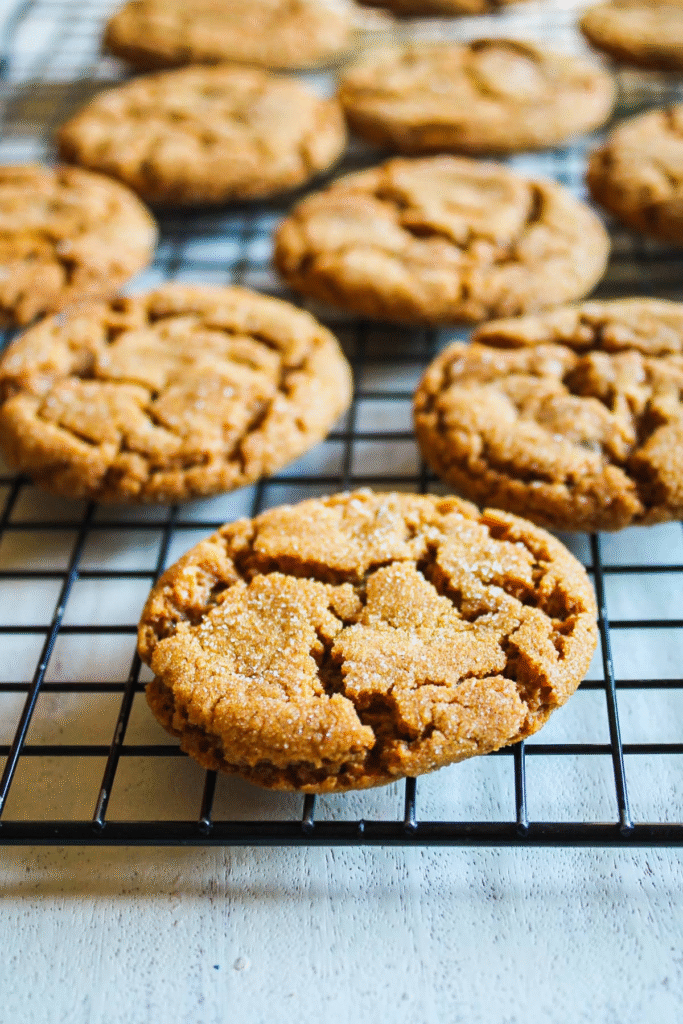These eggless molasses cookies are irresistibly soft and chewy, boasting a bold molasses depth complemented by a cozy blend of warming spices. Each bite melts in your mouth with a buttery sweetness and a hint of spice that lingers just right. Though often associated with classic gingersnaps, these cookies stand apart with their tender texture and egg-free richness—perfect for those who crave comfort in every bite.

❤️ You’ll Love This Eggless Molasses Cookies
Without eggs: No problem! You can absolutely recreate that nostalgic, homemade cookie magic—just like grandma used to make—without using a single egg. These eggless gingersnap cookies pack all the cozy spice, rich flavor, and delightful crunch you crave, with no compromise on taste or texture. You won’t believe how perfectly they turn out—every single time!
Taste & Texture:
- These sugar-crusted gingersnap cookies are a delightful twist on a timeless classic. Made without eggs, they still deliver that nostalgic flavor and texture you love. The deep, earthy sweetness of molasses blends beautifully with the mellow richness of brown sugar, creating a flavor base that’s both bold and comforting. What truly sets these cookies apart is the warming medley of spices—cinnamon, ginger, cloves, and nutmeg.
- Each spice contributes its own personality: cinnamon adds warmth, ginger brings a touch of heat, cloves offer a slightly peppery depth, and nutmeg gives a sweet, nutty aroma.
- The result? An irresistible batch of cookies with a rich, spiced complexity and an incredibly soft, chewy center that practically melts in your mouth. Coated in sugar before baking, they develop a crisp outer shell that contrasts perfectly with their tender interior. Whether you’re craving something cozy with your afternoon tea or looking for a festive treat to share, these eggless molasses cookies are sure to become a favorite in your baking repertoire.
🧾 Ingredient Notes
- Molasses: I prefer using regular unsulphured dark molasses in these cookies because it lends a rich, balanced sweetness and that classic molasses depth without being overpowering. Avoid using blackstrap molasses—it has a much stronger, bitter flavor that can overwhelm the delicate spice blend and throw off the taste of these soft, chewy cookies.
- Spices (cinnamon, ginger, cloves, nutmeg):
- Spices don’t last forever—especially once ground. Their flavor and aroma begin to fade over time, so it’s best to purchase them in small amounts. Always store your spices in a cool, dark place, away from any direct heat or moisture to preserve their potency.
- Adjusting the spice levels in this recipe is completely up to your taste. The measurements I’ve shared reflect my own taste, but don’t hesitate to adjust them to suit your palate. Don’t hesitate to reduce, increase, or skip a spice altogether if it doesn’t suit your palate.
- Nutmeg tip: For the freshest flavor, go for whole nutmeg instead of pre-ground. Just grate what you need using a fine grater or Microplane. Pre-ground nutmeg tends to lose its boldness much faster and won’t give you the same warm depth.
- Baking soda: This leavening agent interacts with the acidity in molasses and brown sugar, helping the cookies puff up slightly while keeping their soft texture.
- Unsalted Butter: Always start with butter that’s at room temperature—soft but not melted. I personally go with unsalted butter to have full control over the salt level in the recipe and to let the buttery flavor shine. If you only have salted butter, that works too—just remember to omit any extra salt from the ingredient list.
- Brown sugar & White sugar: The blend of white and brown sugars does wonders here. Brown sugar brings moisture and depth from its molasses content, while white sugar contributes to that chewy edge and a subtle crispness, creating a cookie that’s rich, flavorful, and perfectly balanced in texture.
👩🍳 How To Make Eggless Molasses Cookies? (Pics)
1) In a mixing bowl, combine all the dry ingredients—flour, baking soda, baking powder, ground ginger, cinnamon, cloves, a touch of freshly grated nutmeg, and a pinch of salt.
2) Whisk them together thoroughly to ensure the spices and leavening agents are evenly distributed, then set the bowl aside.

3) In a separate large bowl, add the softened butter along with both white and brown sugar.
4) Using a hand mixer, stand mixer with the paddle attachment, or even a sturdy whisk, beat the mixture until it’s smooth, fluffy, and light in color.
5) Pour in the molasses and a splash of water, and mix again until everything is fully blended into a silky, uniform mixture.
6) Give the mixture another quick beat until everything is well blended.

7) Slowly incorporate the dry mixture into the wet ingredients, stirring gently until a soft dough begins to form
8) Stir everything together using a spatula (or the mixer on low speed) just until a soft dough forms. Avoid overmixing. Cover the bowl and place the dough in the refrigerator for about 30 minutes to chill.

- Meanwhile, preheat your oven to 350°F (180°C) and allow it to heat fully for at least 10 minutes.
- Line two baking trays with parchment paper. If you’re baking one batch at a time, prepping just one tray is perfectly fine.
9) Scoop out about 1½ to 2 tablespoons of cookie dough and gently roll it between your palms to form a smooth ball.
10) Toss each dough ball in granulated sugar, making sure it’s fully coated.
11) Place the sugar-coated dough balls onto the lined baking tray, leaving about 2 inches of space between them to allow for spreading during baking.
12) Bake in the preheated oven for 12 to 14 minutes, or until the cookies have puffed up and look slightly soft in the center. Leave them on the baking tray for 5 minutes to set, then carefully move them to a wire rack to cool completely.

💭 Expert Tips
- Use Fresh Spices for Maximum Flavor: The key to getting that bold, warm, and comforting flavor in gingersnap cookies lies in the spices. Always use fresh ground spices like ginger, cinnamon, cloves, and nutmeg. Spices tend to lose their potency over time, especially once ground, so if yours have been sitting in the pantry for a while, consider replacing them. Dull or stale spices will make your cookies taste bland and lifeless rather than richly spiced and aromatic.
- Properly Softened Butter is Crucial: Butter should be soft enough to cream easily with sugar, but not melted. The best way to soften butter is to let it sit at room temperature for about 60–90 minutes. Avoid using the microwave, as it tends to partially melt the butter, making it greasy and unsuitable for creaming. Melted or overly soft butter can change the texture of your dough and cause your cookies to spread too much during baking. Properly softened butter will feel cool to the touch and give slightly when pressed.
- Avoid Blackstrap Molasses: While molasses is a signature ingredient in gingersnap cookies, not all molasses are created equal. Steer clear of blackstrap molasses—it’s much darker, thicker, and more bitter compared to regular or light molasses. Using blackstrap can overpower the delicate spice blend and make your cookies taste harsh or too intense. For the best results, stick to regular unsulfured molasses, which offers a perfect balance of sweetness and depth without the bitterness.
Storage:
- Once the cookies have cooled down completely on the baking tray or a wire rack, transfer them to an airtight container for storage. Keeping them well-sealed helps retain their texture and flavor. These cookies stay fresh for about 3 to 4 days when stored at room temperature, making them perfect for make-ahead treats.
- If you prefer your cookies to remain soft and chewy, try placing a slice of plain bread in the storage container along with the cookies. The bread acts as a moisture buffer, helping to keep the cookies tender while it gradually dries out itself. Just be sure to replace the bread slice every couple of days if you’re storing them longer.
- Personally, I find that these eggless molasses cookies taste even better on the second day. After resting for a while, the spices have time to deepen and blend together, making each bite more flavorful. The texture also becomes softer and more cohesive. So if you have the patience, let them sit overnight—you’ll be rewarded with an even richer cookie experience.
Rolling cookies into sugar:
- For a richer flavor and a slightly rustic finish, try rolling your cookie dough balls in natural cane sugar rather than regular granulated sugar. Cane sugar has a coarser texture and subtle molasses undertones, which contribute to a delightful crunch around the edges of the cookies as they bake. It enhances both the visual appeal and the overall taste of your cookies.
- However, if you prefer a less sweet exterior or want a smoother texture, you can skip the sugar-rolling step altogether. Your cookies will still bake beautifully with soft centers and slightly crisp edges, just without the sugary coating. Skipping this step also reduces prep time, making it a great option for a more streamlined baking session.

